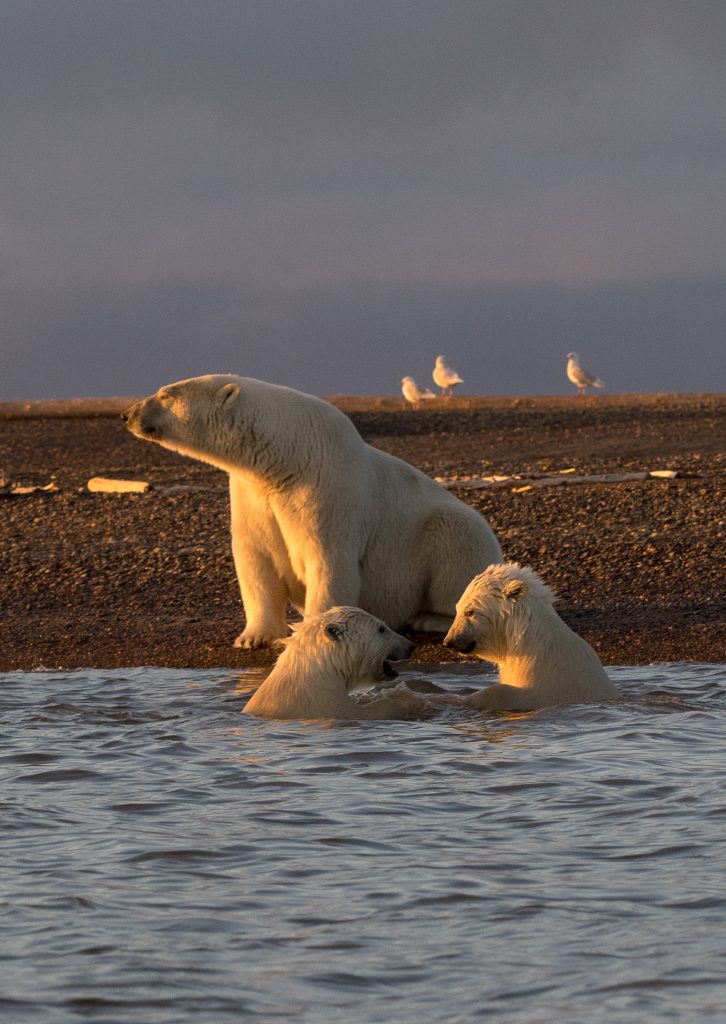My guide, we’ll call him Hank, picks me up from the Fairbanks airport and makes multiple stops to retrieve gear, all of which appears to date back to the Soviet era. In the truck, Hank shakes an old can of bear spray to see if it has anything left in it, before tossing it into the center console, where it begins to leak. My eyes blister, my throat thickens, and I roll down the window to gulp air. Hank coughs and cries but refuses to make a big deal about grizzly-grade pepper spray filling up the cab. He offers to close the lid to the console. I suggest that there’s no way his guests will be able to ride 414 miles on the Dalton Highway for two days without vomiting and passing out in the truck. He reluctantly agrees to ditch the bear spray. I reluctantly agree to stay on the tour. After all, he’s extending it to me as a press trip in hopes that I will write about his company.
Most of the trip, Hank seems to be “winging it.” He’s not mean-spirited. In fact, he’s quite affable and very knowledgeable and passionate about Alaska. He’s just a bit clueless about the minimum standards required for tourism. Case in point: We are driving the Dalton Highway from Fairbanks to Deadhorse instead of flying directly to Kaktovik, ostensibly to “get to know the real Alaska.” Seven of us are crammed into the Ford Excursion, with a week’s worth of luggage, camera equipment, food, and—thankfully—beer. We take turns in the middle seat, elbowing each other. It feels like the Arctic version of National Lampoon’s Vacation, without Chevy Chase to make it interesting or grandma tethered to the roof of the station wagon.
Driving conditions along the way deteriorate on the narrow two-lane, unpaved road. During the winter, the Dalton is the main thoroughfare for more than 250 commercial transport trucks coming to and from Prudhoe Bay. The reality show Ice Road Truckers features the infamous road for its blind curves, potholes, steep drops, frost heaves, avalanches, mudslides, and snowdrifts. At the top of Atigun Pass, a semi-truck slides off the road, which disappears in blowing snow. We see another semi being towed by a semi. On the other side of the pass, the sleet and ice melt, turning the loosely packed dirt and gravel highway to pudding. Hank takes his hands off the wheel multiple times to snap photos with his camera. At one point, he stops in the middle of the road facing oncoming traffic to clean the windows of the vehicle.

Our truck groans and jackhammers its way north. Hank accidentally leaves food and beer outside overnight, which freezes, and forgets a key ingredient for one of the dishes he intended to make for the group. There are no grocery stores or gas stations here. The Excursion has 114,000 hard miles on it and is riding on two spare tires, without any extras for a flat. When we get to Deadhorse, an axle breaks and the wheel comes apart, which is unfortunate since we need it for the return trip. Still, we are one flight away from the bears.
In Deadhorse, high winds strand our group for two nights at an oil camp dormitory in Prudhoe Bay. I have my own room, but unbeknownst to me at the time, I share the bathroom with an oil rig worker, who opens the sliding door from his side, appearing just as surprised to find me as I am him.
Once weather allows us to fly and land safely at our destination in Kaktovik, we pull up to a small house, rather than one of the two hotels in the village, where a few weather-stranded people are already staying. The toilet is broken. The bathroom filthy. A “honey pot” in the corner is suggested. Raw sewage flows beneath the home and into the grass. There is no running water for drinking, showering, or brushing teeth. One of the members of our group finds yellow rubber gloves and cleans the toilet while her husband mops the floor with a paper towel. Hank brings us filtered water to drink, but it still has a suspicious yellow tint to it. I sleep in my clothes on a moldy linoleum floor, shivering and using my parka as a pillow. We are finally in the land of the great white bear, so none of these things matter anymore.

Turns out, seeing a polar bear in the wild is like going through childbirth: you forget the pain that came before it. This magnificent creature erases all—it is simply, unequivocally all there is.
Our last evening, we are on a boat with golden light. A mama polar bear with eight-month-old cubs walks along a spit of land. The cubs swim out to our boat. They dunk each other and play, like children in a pool. I cry when we leave for home—though I shed no tears saying goodbye to Hank, who—after almost a decade—is still convinced I owe his company exposure in the magazine.


Comments are closed.